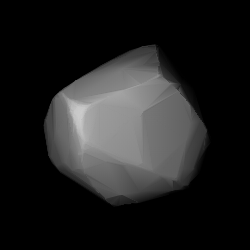 3D convex shape model of 180 Garumna | |
| Discovery | |
|---|---|
| Discovered by | J. Perrotin |
| Discovery date | 29 January 1878 |
| Designations | |
| (180) Garumna | |
| Pronunciation | /ɡəˈrʌmnə/ [1] |
| Main belt | |
| Orbital characteristics [2] | |
| Epoch 31 July 2016 (JD 2457600.5) | |
| Uncertainty parameter 0 | |
| Observation arc | 96.73 yr (35331 d) |
| Aphelion | 3.1722 AU (474.55 Gm) |
| Perihelion | 2.2739 AU (340.17 Gm) |
| 2.7231 AU (407.37 Gm) | |
| Eccentricity | 0.16494 |
| 4.49 yr (1641.3 d) | |
| 301.92° | |
| 0° 13m 9.624s / day | |
| Inclination | 0.86595° |
| 312.18° | |
| 175.87° | |
| Earth MOID | 1.28761 AU (192.624 Gm) |
| Jupiter MOID | 1.89216 AU (283.063 Gm) |
| TJupiter | 3.338 |
| Physical characteristics | |
| 23.866 h (0.9944 d) | |
| S [3] | |
| 10.31 | |
180 Garumna is a main belt asteroid that was discovered by the French astronomer Henri Joseph Perrotin on January 29, 1878. [4] Its name comes from the ancient Latin name for the Garonne River in France. In the Tholen classification system, it is categorized as a stony S-type asteroid, while the Bus asteroid taxonomy system lists it with the Sr sub-type. [3]
The rotation period of this asteroid is very nearly equal to that of the rotation of the Earth. This means that only a small portion of the light curve can be observed from any one location, requiring measurements from multiple sites in order to build a complete curve. In 2012, this mission was accomplished, giving a period of 23.866 ± 0.001 hours with a brightness variation of 0.42 ± 0.02 in magnitude. Allowing for a margin of error and changes in phase angle, this finding agrees with previous measurements made in 2008 and 2011. [5]